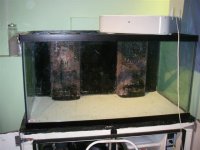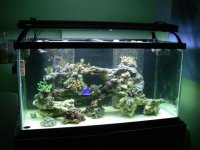I've read a lot of posts about faux sand beds, but never much of a dummy's step by step guide so figured I'd post my experiences.
I have a 120 gal Megaflow AGA that started with about a 3" sand bed, then I slowly started removing it during water changes because I wasn't too happy with my coral health. Finally the combination of my water parameters and a nuisance perch that was bullying everyone (pointing at the tank and yelling 'avada kedavra' didn't seem to work) led me to tear the tank down and replace the substrate.
I started by filling up a couple of Rubbermaid tubs and moving my corals and "interesting" (had fun stuff growing on it) live rock into one. Some more rock and the fish went into another. Heaters and powerheads into each.
The rest of the live rock just went into salt mix buckets using the old tank water and was left to sit (it's summer, so the room isn't too cool).
With the empty tank left, I scraped the glass really well and then siphoned/scooped out all the sand. Once the bottom was mostly clean, I dumped in a bucket of fresh water and drained that off as well. Then towel dried the inside of the tank and was ready to go.
I bought a 32oz box of EnivroTex Lite Pout-on High Gloss Finish epoxy from a Michael's craft store. It cost around $35.
To mix it I cut the top off a 2L pop bottle (despite the instructions protesting that you should have a flat-bottomed container). I dumped in the resin and the hardener and mixed vigorously with a stick (a paint mixing stick from a hardware store would work really well here) for about 3 minutes. You can see the epoxy start to discolour a bit as you mix it together - it almost looks like there's a thermocline that you are mashing up.
I was really quite worried about the epoxy hardening so I rushed. With life to live over I'd take my time - it's not going anywhere in 5 minutes so relax.
I poured the whole container around the base of the tank and then used a piece of cardboard to spread it around so the bottom looked smooth and full. The instructions for the epoxy say that 32oz is enough for 8sq ft. My tank is exactly 8 sq ft (minus overflows) but I thought I could probably pull it off.
Finally, I took about a 1/2 gal container of clean aragonite sand and sprinkled it over the base of the tank.
From time to time the sand would get a "wet" look as the epoxy absorbed it and started to come up, so I just kept throwing more and more sand on. Once it looked like a layer of dry sand I left it overnight.
Worried about heat expansion breaking the tank (as per the rather bad experience on that RC post), I set up a large fan blowing into the tank overnight to try and dissipate the heat a little quicker. In the end this wasn't an issue - it never really got warm. I strongly suspect the problem the guy with the 240 had was not heat related but rather due to pressure points.
About 48 hours later (the cure time was given at around 36 hours based on my room temperature) I put in a few buckets of fresh water and siphoned out all of the loose sand.
One complaint I have is that the epoxy didn't coat 100%, though I had thought it did. There are a few small areas, and much of the border around the silicone that are still bare. It's not enough to moan about as the live rock covers them up sufficiently and I suspect the coralline will cover it regardless.
Finally I drained every last bit of freshwater out (just in case there were any toxins that got washed out on the surface of the epoxy - though I somehow doubt it) and began filling the tank with warm water.
This was a bit of a pain because I have a few chitons that moved into the small gap in the baffles of my overflows and could not be removed. They survived the trip from the collection point in Tonga to my tank so I suspect they survived 48 hours out of water just fine. It did mean I couldn't just fill the tank with freshwater and dump in salt when finished as that would probably have done them in. Instead I dumped in cup after cup of salt throughout the filling process and somehow ended up with 1.025 SG without ever measuring during filling.
The rest of the moving in was easy - reaquascaping (needed the gf to do it as my brain isn't capable of such a task), reconfigure the corals, and drop the fish back in.
It's now been 24 hours since we moved back in and I'm quite happy. The sand bed looks good and the fish are active. The corals are slowly opening and none seem to have perished. My skimmer cup was completely full this morning, having been emptied last night, so I suspect the epoxy might have had something to do with it.
If anyone is considering doing this I would recommend it - it's a ridiculously easy DIY (though obviously there are a lot of logistics involved if your tank is already running) and gives a nice result. I suspect that the majority of the cautionary tones you see online are the usual fish forum hysteria and there is actually very little real danger involved.
I have a 120 gal Megaflow AGA that started with about a 3" sand bed, then I slowly started removing it during water changes because I wasn't too happy with my coral health. Finally the combination of my water parameters and a nuisance perch that was bullying everyone (pointing at the tank and yelling 'avada kedavra' didn't seem to work) led me to tear the tank down and replace the substrate.
I started by filling up a couple of Rubbermaid tubs and moving my corals and "interesting" (had fun stuff growing on it) live rock into one. Some more rock and the fish went into another. Heaters and powerheads into each.
The rest of the live rock just went into salt mix buckets using the old tank water and was left to sit (it's summer, so the room isn't too cool).
With the empty tank left, I scraped the glass really well and then siphoned/scooped out all the sand. Once the bottom was mostly clean, I dumped in a bucket of fresh water and drained that off as well. Then towel dried the inside of the tank and was ready to go.
I bought a 32oz box of EnivroTex Lite Pout-on High Gloss Finish epoxy from a Michael's craft store. It cost around $35.
To mix it I cut the top off a 2L pop bottle (despite the instructions protesting that you should have a flat-bottomed container). I dumped in the resin and the hardener and mixed vigorously with a stick (a paint mixing stick from a hardware store would work really well here) for about 3 minutes. You can see the epoxy start to discolour a bit as you mix it together - it almost looks like there's a thermocline that you are mashing up.
I was really quite worried about the epoxy hardening so I rushed. With life to live over I'd take my time - it's not going anywhere in 5 minutes so relax.
I poured the whole container around the base of the tank and then used a piece of cardboard to spread it around so the bottom looked smooth and full. The instructions for the epoxy say that 32oz is enough for 8sq ft. My tank is exactly 8 sq ft (minus overflows) but I thought I could probably pull it off.
Finally, I took about a 1/2 gal container of clean aragonite sand and sprinkled it over the base of the tank.
From time to time the sand would get a "wet" look as the epoxy absorbed it and started to come up, so I just kept throwing more and more sand on. Once it looked like a layer of dry sand I left it overnight.
Worried about heat expansion breaking the tank (as per the rather bad experience on that RC post), I set up a large fan blowing into the tank overnight to try and dissipate the heat a little quicker. In the end this wasn't an issue - it never really got warm. I strongly suspect the problem the guy with the 240 had was not heat related but rather due to pressure points.
About 48 hours later (the cure time was given at around 36 hours based on my room temperature) I put in a few buckets of fresh water and siphoned out all of the loose sand.
One complaint I have is that the epoxy didn't coat 100%, though I had thought it did. There are a few small areas, and much of the border around the silicone that are still bare. It's not enough to moan about as the live rock covers them up sufficiently and I suspect the coralline will cover it regardless.
Finally I drained every last bit of freshwater out (just in case there were any toxins that got washed out on the surface of the epoxy - though I somehow doubt it) and began filling the tank with warm water.
This was a bit of a pain because I have a few chitons that moved into the small gap in the baffles of my overflows and could not be removed. They survived the trip from the collection point in Tonga to my tank so I suspect they survived 48 hours out of water just fine. It did mean I couldn't just fill the tank with freshwater and dump in salt when finished as that would probably have done them in. Instead I dumped in cup after cup of salt throughout the filling process and somehow ended up with 1.025 SG without ever measuring during filling.
The rest of the moving in was easy - reaquascaping (needed the gf to do it as my brain isn't capable of such a task), reconfigure the corals, and drop the fish back in.
It's now been 24 hours since we moved back in and I'm quite happy. The sand bed looks good and the fish are active. The corals are slowly opening and none seem to have perished. My skimmer cup was completely full this morning, having been emptied last night, so I suspect the epoxy might have had something to do with it.
If anyone is considering doing this I would recommend it - it's a ridiculously easy DIY (though obviously there are a lot of logistics involved if your tank is already running) and gives a nice result. I suspect that the majority of the cautionary tones you see online are the usual fish forum hysteria and there is actually very little real danger involved.







